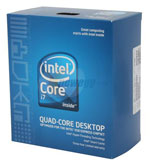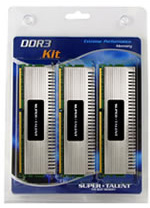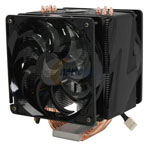Intel Performance Midrange
In recent months, AMD is finally effectively competing in midrange computer systems. With the AMD Phenom II line, Intel and AMD enjoy rough parity in the price ranges and processor speeds where they compete. Of course, the top AMD still cannot compete with Intel Core i7, which remains the performance leader. We could have chosen an Intel CPU for our performance midrange that would have competed very well with the AMD Phenom II 955BE used in the AMD performance midrange setup. The problem with that is we would not make that choice ourselves. If we were spending $1600 or more a system, we would definitely stretch the extra $150 to buy a Core i7-920 system. That is exactly what we did for the Intel performance midrange system. (You can of course trim down other component choices to get into a Core i7 system for less money, but we're going with the type of system we would like to build.)
The reasoning was very simple. It was difficult to recommend another Intel system at anywhere close to the price point of the i7-920, and socket 1366 components have been dropping in price over the past three months. For those reasons if you plan to spend over $1000 on a base Intel box you should definitely consider a Core i7-920 system. That will likely change with the coming i5 release providing additional Intel midrange choices.
| Intel Performance Midrange PC | ||
| Hardware | Component | Price |
| Processor | Intel i7 920 Nehalem Socket 1366 (2.66GHzx4 4x256MB L2, 8MB L3 Cache) | $280 |
| Cooling | Vigor Monsoon III LT for Socket 1366 | $55 |
| Motherboard | GIGABYTE GA-EX58-UD3R LGA 1366 Intel X58 ATX (after $15 rebate) | $180 |
| Video | MSI Radeon HD 4890 1GB OC Edition (After $30 Rebate) | $170 |
| Memory | Super Talent Chrome 6GB DDR3-1600 Triple Channel Kit WB160UX6G8 8-8-8-18 | $96 |
| Hard Drive | Western Digital Caviar Black 1TB WD1001FALS | $95 |
| Optical Drive | LG BD/HD DVD 8X BD read/16x DVD read/write CH08LS10 - Retail | $130 |
| Audio | On-Board | $ - |
| Case | Cooler Master Storm Scout SGC-2000-KKN1-GP Mid-Tower | $100 |
| Power Supply | Corsair CMPSU-750TX 750w 80 PLUS Certified SLI/Crossfire Ready Core i7 Power (after $20 Rebate) | $100 |
| Base System Total | $1206 | |
| Display | ASUS VW266H Black 25.5" 2ms(GTG) HDMI Widescreen LCD Monitor (1920x1200) (after $30 Rebate) | $300 |
| Speakers | Logitech G51 155 watts RMS 5.1 Surround Sound Speakers - Retail | $120 |
| Input | Microsoft CA9-00001 Black PS/2 Standard Keyboard and Optical USB/PS2 Mouse - OEM | $16 |
| Operating System | Microsoft Vista Home Premium OEM | $99 |
| Complete System Bottom Line | $1741 | |
| SSD (Optional) | OCZ Vertex OCZSSD2-1VTX120G 2.5" 120GB SATA II MLC Internal Solid State Disk | $339 |
 |
The i7-920 is the lowest priced Intel Core i7 you can currently buy. The other choices, even after the recent i7-975 and i7-950 introductions, are in the $562 to $1000 range. Don't assume, however, that the 920 isn't a powerful processor. The i7-920 is capable of reaching the performance levels of the top i7 CPUs, because it has also proven to be a dynamite overclocker for those who care about that - provided they are also willing to provide decent cooling to the i7-920.
The Core i7-920 is 30% faster in some parameters than a Core 2, and you can overclock this 2.66GHz CPU to 3.8GHz to 4GHz with careful tweaking and better cooling. As shown in the Phenom II launch, the 920 reached as high as 3.8GHz at stock voltage and 4.0GHz when overvolted to 1.35V. That is a 50% overclock without a ton of effort on air-cooling. You will certainly be very happy with Core i7 base performance, but if you are interested in overclocking you will be extremely pleased with this CPU.
 |
The GIGABYTE GA-EX58-UD3R remains the X58 board of choice for the Core i7-920. It is one of the least expensive X58 chipset motherboards currently available. Others have joined that +/-$200 X58 club in recent months, but the GIGABYTE still provides excellent value and is now selling with a rebate that reduces the price to $180. Test results and user reports for the GIGABYTE EX58-UD3R are very favorable. This low-priced X58 board also excels in overclocking, which is why it remained the motherboard choice for the performance midrange Intel system. Other good choices are the MSI X58 Pro LGA 1366 and the ASRock X58 Deluxe LGA 1366.
 |
Super Talent introduced an excellent 6GB triple-channel memory kit in their Chrome DDR3-1600. This Super Talent 6GB kit is another low-voltage memory kit preferred in AnandTech memory testing. Specifications are 8-8-8-18 timings at DDR3-1600 and 1.65V. This triple-channel memory kit provides excellent value in a 6GB kit and overclocking headroom to spare with its low voltage design. Six months ago in our last midrange guide, a slower 6GB kit set you back $145 where the Super Talent DDR3-1600 is now $96. DDR3 prices just continue to drop. You can select from a number of quality memory suppliers, but make sure to include their warranty and customer service reputation in your decision-making.
 |
Unfortunately, the Core i7 CPU runs hot and eats lots of power. In fact, the stock Intel HSF is barely adequate for the CPU, which is a change in philosophy from lower Intel processors. For those reasons we almost always recommend a third party CPU cooler for an i7 system - particularly if you plan to overclock at all. Our cooler choice to mate with the GIGABYTE X58 board is the Vigor Monsoon III LT at $55. This Monsoon is a standard vertical heatpipe air-cooler, with effective and quiet push-pull cooling. The Monsoon appears a good match to the OC capabilities of the i7-920. Another excellent option is the Thermalright Ultra 120 eXtreme with the 1366 mounting kit. You pay a bit more for the Thermalright cooler, but this top Core 2 cooler also works very well when paired with a Core i7.










71 Comments
View All Comments
ChrisOjeda - Monday, July 27, 2009 - link
Will onboard video (like ASUS M4A78T-E) be a solid solution for somebody that does no gaming, but would like to make a home theatre box for watching movies, playing music, and viewing pictures using a Windows solution. I have no intention of gaming on the machine and don't want to spend more than necessary for a video card. Assume all other components the same.JarredWalton - Monday, July 27, 2009 - link
Yes. If you're a stickler for audio, make sure it's an IGP that can handle multi-channel LPCM audio output. NVIDIA has had this for a while, Intel added it a year or so back, and http://www.anandtech.com/weblog/showpost.aspx?i=62...">AMD just added it with the R785 (HD 4200).garydale - Monday, July 27, 2009 - link
The AMD 790GX chip does pretty reasonable graphics for the non-gamer so I went with the Gigabyte GA790GP-UD4H (or some similar number) board. The six onboard SATA2 ports meant that my software RAID 5 array (4 x 500G) still allowed me to plug in a SATA DVD rewriter.With a Phenom II 940 processor, the total build (less monitor - still using an old Dell 21" trinitron) was pretty small. I found a 470watt PC Power & Cooling Silencer on sale last year and stuffed it in a case I'd picked up years ago.
The processor runs quite cool thanks to the new cooler AMD puts on them - about the same temp I was getting with with an earlier Phenom X4 and a Gladiator Max cooler. It's the hard drives that are running hot, so I'll need to add another fan at the back to pump more hot air out.
Just waiting for the Blu-ray burner costs to come down. They haven't really moved in the last year, which is disappointing. Does anyone have any idea on why the prices are staying high? I notice the media prices have been dropping, so when can we expect a $100 Blu-ray burner?
goinginstyle - Monday, July 27, 2009 - link
I was surprised that I did not see a AMD 770 or cheap Intel P45 based system with the 4890 as the video card choice for the midrange system. The money you save on the board allows you to upgrade the video card choice and performance looks to be the same. Maybe overclocking is not as good but does it really matter that much.You end up with a single video card on the board but it also allows you to save money on the power supply choice, which might get you a better audio selection or two hard drives. I think having alternatives listed in these guides would be good, otherwise most of the choices were solid.
brybir - Monday, July 27, 2009 - link
I was looking for the 780G as well. I think they were looking for "gamer" boards with the option to Crossfire or SLI or whatnot over strictly budget options since this is a "middle of the road" system guide for both casual gamer types as well as those in the upper end of the price range who want very good system speed.If I were building a mid range system (I am going to build one come early 2010 when Intel's i5 line is more flushed out and the new gen of graphics cards are released in oct/now) I would probably pick up a 780G board and use the money to go from the 4870 to the 4890 or even just use the money for a bump in LCD quality.
Black Jacque - Monday, July 27, 2009 - link
This article makes some good points in graphics and CPU selection. However, it shows the Editors have a poor understanding of PC power consumption.By reasonable accounts, all the PSUs in the recommended systems have twice the rated wattage that the parts lists will draw at full core-burning maximum. For the mid-range, a 400W-450W PSU is more than enough.
The recent, excellent Xbit Labs article "PC Power Consumption: How Many Watts Do We Need?" clearly illustrates that 750W PSUs are a waste of money in the mid-range when not going with SLI or Crossfire. This article shows the trend in PC parts is downward in power consumption.
When building a mid-range machine, you need to keep your eye on your budget. You are trading dollars for performance in every choice. A 450W PSU is less expensive than a 750W PSU. That difference is one budget bump UP toward either a: faster CPU, an upgraded GPU, or more RAM.
The high-wattage PSUs in the parts lists show a poor understanding of PC power consumption. Selecting lower wattage, PSUs that perform as needed in high performance situations (and more efficiently at idle) allows for higher performance parts to be used in the price/performance mid-range categories, or generally lower the cost-of-entry to a category. I expected a more canny and not “Big is Best” recommendation of PSUs in this article.
The0ne - Monday, July 27, 2009 - link
While there's already arguments going back and forth on this it's usually a good idea to buy a beefier but not necessarily more expensive PS. The reason is because many users don't have the capability to determine precisely how much power their system is consuming. Hell, I'm an Engineer and I don't have the tools at home to even do it. So I can't expect the same for your average Joe to be capable of. Secondly, not all low range, mid-range or high end configurations are the same. Some have more components and some have the basics. Having more requires a bit more power.In addition, not all power supplies are created equal. Even same power supplies are not exactly the same. And while specs are great to look at chances are if you don't know what you have in the first place it's best if you look for a performance/price deal that is more than what you "think" you need.
Due to reviews I keep seeing people make comments like "consumers only need 400-450 watt for their mid-range computer!" While this may be true for most cases it is not entirely 100% foolproof. For example, my 600watt PS in my main refuses to run my new 4870 1Gig video card where it's already powering my current 9800GX2. Why, I've no idea. I just know that I had spent hours trying to determine it with little success except the PS is not what the specs are telling me.
So I pop in the OCZ 700, after doing some research and knowing I would have some good buffer afterward, and my system is running just fine. I'm not maxing it so I really don't have to pay attention to the tight specifications. What matters was that I bought it for $50 when it was on sale and there wasn't a similar PS that came close in price. That's what importantly :)
SiliconDoc - Wednesday, August 5, 2009 - link
You don't need home tools to determine what PS requirements are, there are tools all over the internet - how about one form the experts:http://www.thermaltake.outervision.com/">http://www.thermaltake.outervision.com/
---
Now they make PS's and you would think they would promote a higher number, but run through it once and you'll likely find a much lower result than you expected.
The0ne - Monday, July 27, 2009 - link
Speaking of PS, here's the one I got...and it's on sale again for $49 after rebate :ohttp://www.zipzoomfly.com/jsp/ProductDetail.jsp?Pr...">http://www.zipzoomfly.com/jsp/ProductDetail.jsp?Pr...
Nfarce - Monday, July 27, 2009 - link
"For the mid-range, a 400W-450W PSU is more than enough. The recent, excellent Xbit Labs article "PC Power Consumption: How Many Watts Do We Need?" clearly illustrates that 750W PSUs are a waste of money in the mid-range when not going with SLI or Crossfire."Uhm, yes and no. As someone who recently build an E8400 mid range gaming system who also has the Corsair 750W, there are things you need to consider other than pure wattage. For instance there are hardly any quality power supplies in the 450-550W range that offer 2 6-pin PCIe connectors (a requirement to run HD 4870/90 and GTX 260/275 cards). Finally, the ones that do aren't that much less expensive. If you are going to spend $75 on a minimum requirement power supply, it makes good long term sense to throw in another $25 and get a more powerful PS for your future upgrade needs. Power supplies, unlike other PC components, don't really drop in price over time.